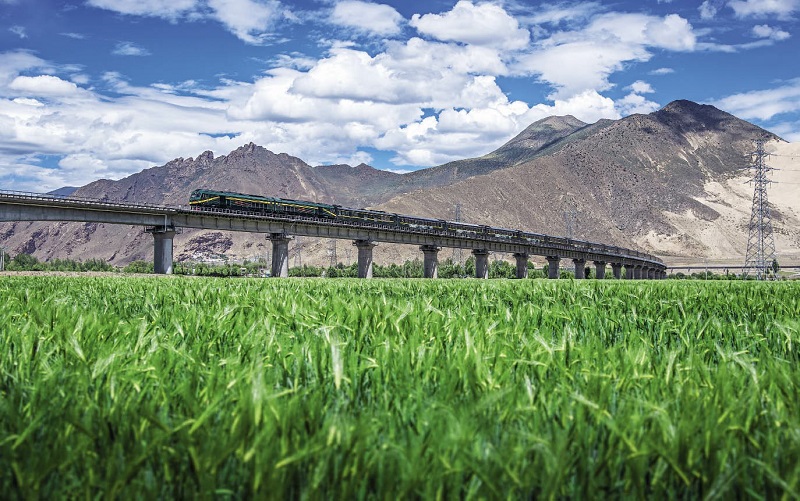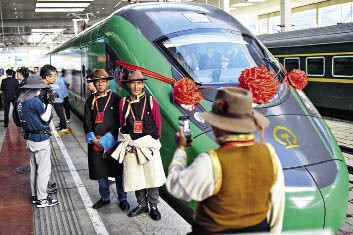To the music of the Chinese popular song Heavenly Road, a bullet train rolled into the Lhasa Station at 10:30 a.m. on June 25, 2021. Many people waiting on the platform took out their cell phones to take photos of the momentous event of the first running of the first electric rail track in southwest China’s Tibet Autonomous Region. The operation of the rail line connecting Lhasa with Nyingchi heralded an era of the bullet train on the snowy plateau.

An express train of the Lhasa-Xigaze line travels over barley fields in the Yarlung Zangbo River Valley in June 2020.
Transforming Local Life
The prospect of building and operating railways in Tibet once seemed like a pipe dream. Back in 1919, Sun Yat-sen proposed the building of a rail line between Lhasa and Lanzhou. Henry Donald, an Australian reporter once worked for the U.S.-based The New York Herald, a large-distribution newspaper that existed between 1835 and 1924, thought it was impossible, saying even yaks could not reach that region. This proposal, however, became a reality after the founding of the People’s Republic of China.
The launch of the Qinghai-Tibet Railway in 2006 ended the period of history in Tibet without trains, opening a new chapter in the development of modern transportation in the region. In 2014, the Lhasa-Xigaze Railway became operational, cutting the commute time between the two cities from six hours by bus down to about three hours by train. The inauguration of the Lhasa-Nyingchi Railway is another milestone in the railway development of Tibet.
Jamyang Qoizhag and his family traveled from Lhasa back to Xigaze by a high-speed train. The 12-year-old said his mother takes him and his brother on vacation every summer. In the past, they traveled by bus, then by normal train, and now by bullet train. This was their first ride on a bullet train, and Jamyang Qoizhag was excited, “It is fast, comfortable, and beautiful.” “This line is newly opened. Since it is now the peak season for tourism, it is difficult to get tickets. We booked them by smartphone three days ago,” his mother added.
Dazhin, head of passenger services at Lhasa Station, said that the Lhasa-Xigaze line mainly serves commuters between the two cities, the largest in Tibet. “The train now is faster and safer,” Dazhin said. Road traffic would be suspended in summer when the frozen soil melts and the roads become slushy, and driving was even more dangerous in winter with fatal car accidents happening from time to time. “Now, rail has become the most favored choice for locals,” said Dazhin. Last year, 779,000 people set off from Xigaze Railway Station, a six-fold increase from 2004, she noted.
The new rail line not only improves public transport, but will also boost economic development in Tibet. The Lhasa West Station is the largest and highest-altitude cargo train depot in the Tibet section of the Qinghai-Tibet Railway. According to station chief Zhang Qiang, goods going through this station include almost everything people can think of, from sewing needles to steel bars for construction projects. “The weather is volatile on the plateau. Transportation by road and air is more vulnerable to the weather, while rail transport is more convenient, safe, and fast, and also provides cold storage,” Zhang explained why the rail transportation was the first choice for many consignors.
During the past 15 years, the number of logistics companies has increased from the original four to over 40, shipping a variety of goods including bottled water, beer, and other food products. In 2006, the station sent off 20,000 tons of goods, and received 291,000 tons. In 2020, the figures ballooned to 491,000 and 6.15 million, respectively. The annual throughput grew 20-fold during this period. The increasing flow of goods into and out of Tibet testifies to the improving living standards in the region.

Twelve-year-old Jamyang Qoizhag and his family take the train home after a visit to Lhasa.
Bringing Tibet Closer to the Outside World
Few know better than railway workers how the railway has changed the landscape of Tibet. Dazhin is among the first employees of China Railway Qinghai-Tibet Group Co., Ltd. During the 15 years, she has witnessed the completion of the Qinghai-Tibet, Lhasa-Xigaze, and Lhasa-Nyingchi railways, and watched the transition of Lhasa Station from being the tallest building in its surrounding area to one overshadowed by skyscrapers. “As people said in old times, ‘When the train horn is heard, one knows fortune is coming their way.’ Once the railway reaches a region, its economy begins to take off,” she said.
Liu Mengjiao, chief conductor of train D8983, has been working on the Qinghai-Tibet line for nine years. According to her observation, the pristine scenes out of the window have largely remained intact, but changes inside the train are remarkable, “Trains are better equipped and run faster now. More people are traveling by train,” she said. A new feature of the bullet train is the emergency oxygen kit under every seat. “Passenger safety is always our top priority,” said Liu.
Since its launch, the 755-seat bullet train has been booked to capacity every trip. Liu and her colleagues are busy but happy. “Passengers, many of whom are Tibetans, often help us carry large suitcases, and we are glad to help anyone who faces a language barrier,” Liu said. She noticed that the train has brought local Tibetans closer to the world outside the plateau and helped them adapt to a modern lifestyle.
Passengers on the train consist of people of different ethnicities and nationalities. “Before the outbreak of the pandemic, we received tourists from Europe, the U.S., and Southeast Asia every day,” Liu said. To better serve them, the crew set up a communication team whose members can speak fluently in English. A handshake or a pat on the shoulder by foreign passengers is an expression of satisfaction with the performance of Liu and her colleagues. “This railway has shortened the distance between Tibet and the rest of the world, and brought more people around the world into Tibet to better understand it,” Liu said, adding that she is proud to work on this line.

Two passengers pose for a photo with the first train on the Lhasa-Nyingchi Railway Line at the Lhasa Station on June 25, 2021.
Expanding the Rail Network
The Qinghai-Tibet Railway is the longest and highest-altitude rail line in the world, and runs across the longest stretch of frozen soil, making it an engineering marvel. China has planned more railways in Tibet during the next five years.
The Ya’an-Nyingchi section of the Sichuan-Tibet Railway will be built, and preparatory work for the construction of the Yunnan-Tibet Railway, and the Xinjiang-Tibet Railway will be made. Also in preparation are the projects of electrifying the Xigaze-Gyirong section of the China-Nepal Railway, Golmud-Lhasa section of the Qinghai-Tibet Railway, and the Lhasa-Xigaze Railway, as well as supporting power supply projects.
The Lhasa-Xigaze Railway is the first extension line of the Qinghai-Tibet Railway. More lines will be built to reach destinations on China’s border with Nepal, and eventually get connected with railways in the neighboring country. The Ya’an-Nyingchi line under construction is part of the Sichuan-Tibet Railway. When it is completed, the entire railway will be in operation.
According to the official WeChat account of China State Railway Group Co., Ltd., the Ya’an-Nyingchi line is 1,011 kilometers long, with a designed speed ranging from 120 to 200 kilometers per hour. A total of 26 stations will be built along the line. Its total investment is estimated at RMB 319.8 billion. Construction kicked off last November, and is scheduled to conclude in 10 years. When it becomes operational, train travel between Lhasa and Chengdu, capital of Sichuan Province, will take only 10 hours.
According to an official from the Development and Reform Commission of Tibet Autonomous Region, in the coming years, Tibet will continue to meet the needs of transport within and outside of the region, make fresh progress on the Ya’an-Nyingchi section of the Sichuan-Tibet Railway, and speed up electrification of existing lines and preliminary work on the Xinjiang-Tibet, Yunnan-Tibet, and China-Nepal railways. The goal is to establish a railway network covering the entirety of Tibet and reaching out to China’s neighbors.
Thanks to the booming railway sector, Tibet is seeing an upgrade of transportation infrastructure, a better business environment, and thriving socio-economic development. These contribute to the region’s high-quality development and lasting stability.